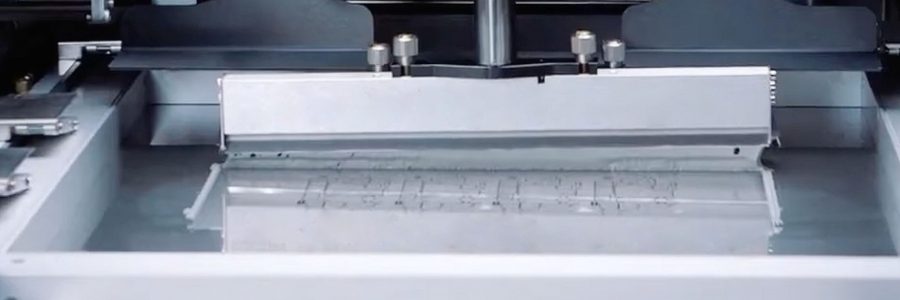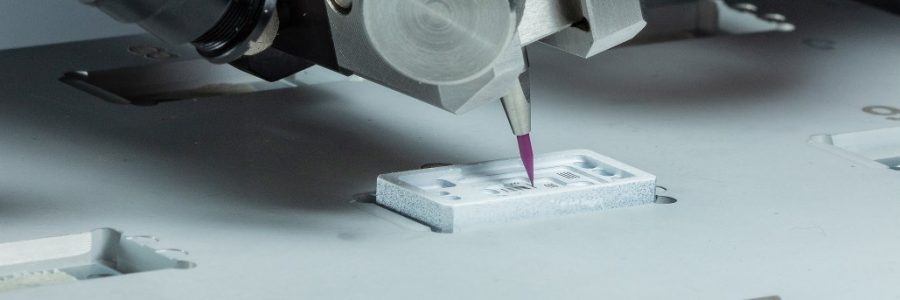Stencil Printing vs Dispensing
Author: Wenjay Tew Wen Kiat, Last update on March 14, 2025, Prepared by the NSW Automation Marketing Team

How to choose? Stencil Printing (screen printing) or Fluid/Epoxy Dispensing
There are many discussions on the differences between stencil printing and fluid dispensing in the semiconductor industry. The conversations of especially its pros and cons, happen because these are two primary technologies currently used to automate the distribution of non-conductive and conductive fluid such as solder paste or silver epoxy in precise volumes.
Perhaps you might ask “Heard of a solder stencil? it pretty much makes solder dispensing useless.” Let us answer this question with the detailed articles below.
Both technologies dispense fluid, adhesive liquid or epoxy for electronic devices, but each has distinct functions. The differences between stencil printing and fluid dispensing are essential, as it influences the overall cost and efficiency of the automation process.
In addressing these differences, here is something that we have written to help our users understand the differences between the two technologies. We have also listed some of the pros and cons associated with each method.

What Is Stencil Printing (Screen printing)?
Think of stencil printing as silkscreen screen printing. Primarily In the automated manufacturing industry, stencil printing technique is where conductive adhesives such as solder paste, silver epoxy, or other epoxy are printed unto printed writing boards or a substrate through a pre-made template through a relative aperture layout. This printing happens at a very fast pace in a mass-production setting.
Stencil printing is the technology that enables manufacturers to produce large volumes of identical, complex printed components or assemblies. Such printing is used for PCBs, modules, printed circuit boards (PCBs), printed wiring boards (PWB), as well as printed circuit assemblies (PCAs).

What Is Fluid Dispensing?
Fluid Dispensing (in terms of Micro-dispensing) is a method that uses dispensing technology to precisely dispense a controlled quantity of any fluid, solder paste, silver epoxy, or other epoxies to a chip, substrate, or electronic device (e.g., MEMS, 008004, 0201, 3D-SiP, LED, VCSEL and etc.). The goal of this method is to dispense the exact amount of fluid into targeted areas accurately. Therefore, conductive materials that are dispensed are at low quantities and precise volume.
The technology enables manufacturers to dispense a desired quantity of a liquid material automatically and accurately unto targeted areas of a substrate. This method is also suitable to dispense specialty substances on uneven surfaces too.
Pros and Cons of using Stencil Printing Equipment. (Screen Printer)
Here are some disadvantages and advantages of the usage of stencil printing equipment.
Pros of Stencil Printing Equipment
1. Lower Investment Equipment Cost
- Stencil printing equipment is generally cheaper as compared to dispensing machines.
- However, it may result in more cost for your bottom line in the long term (after a minimum of 3 years). This is particularly true if you use stencil printing for low volume production instead of investing in a dispensing machine. Such costs are reflected when extra labour costs, materials (like cleaning materials and stencils), reworks, and wastages are taken to account.
2. More Room for Your Workspace
- You save space when using a stencil printer for adhesive or epoxy printing. This is because, as compared to fluid dispensers, there is no need for numerous dispensing machines running together concurrently to meet the speed of a stencil printer: fewer machines, more room space.
3. Excellent Throughput
- Stencil Printing is fast and saves time. A typical tact time of printing is 10 to 15 seconds per board (which can produce 4 to 6 PCBs per minute) compared to 1 printed circuit board per 4 minutes (on component placement). However, this speed is only advantageous for “high-end, high-speed” chip-shooters and not for detailed printing that requires time.
Cons of Stencil Printing Equipment
1. Costly Cleaning
- Since stencil printing is fast, there is equally a need for fast maintenance. Cleaning is required every 2 to 3 hours to maintain performance and prevent aperture clogging issues. The cleaning chemicals used are hazardous (xylol, acetone, etc.) and poses a safety concern to the operators involved.
- It is also costly to install safety equipment like exhaust fans to clear toxic fumes (close to US$6000).
- Averagely, the cost for stencil cleaning rates between US$12,800 – US$40,000.00, and this excludes the cost of cleaning solutions/agents.
- The average time for cleaning time is around 2-3 minutes per stencil. Therefore, it could be exorbitant when extra costs like labour summed to your expenditure.
2. The Cost of Stencils is High
- Unlike fluid dispensing machines, users often find themselves replacing stencils quite frequently. Replacement happens whenever there is a problem in design layout, new products, or revisions that affect PCB layout. Unfortunately, frequent changes also mean higher costs, which means a heavy bottom line to bear.
3. High Material Wastage
- Screen printing generally uses a significant amount of solder paste due to its large stencil size and wide surface coverage. Insufficient fluids may result in an uneven deposition during the end process. Furthermore, solder pastes are likely to degrade under long atmosphere exposure, causing the flux inside to evaporate. Once compromised, it is harder to continue the soldering process onto another conductor.
- Generally, a typical stencil life lasts between 3 to 4 hours. It is important to constantly change exposed materials (never “recycled”) after a few usage cycles to upkeep quality, performance, and maintenance as best practice. However, this increases waste and adds cost to your process too.
4. Inflexibility of Fluid/Epoxy Volume
- The thickness of the stencil defines fluid distribution volumes, which are unfortunately fixed and unchangeable. With the exception of electronic chips, it limits the range of components (stand-off height), which could be easily glued with a stencil.
5. Printing is a Challenge Due to Smaller Holes
- Due to smaller sized aperture and narrow shape, fluid distribution from stencil printing is more challenging (due to smaller gaps) and causes clogging issues—especially without timely maintenance. This makes it challenging when working with screen printing materials such as solder paste.
6. Longer Set-up time
- Compared to dispensing equipment, stencil printers take more “set-up time” when using a semi-auto printer.
7. More Rework is Required
- Should there be an insufficient amount of fluid distribution during the printing process, there is a possibility of detachment or skewing during the processing and placement of the printed component. On the other hand, if fluid/epoxy volumes are excessive, it will infringe on the land patterns—causing opens and wastage. This means more costs spent and reworks to do.
8. Contamination of materials if not properly cleaned
- There is a high possibility of solder paste contamination if there is no proper maintenance done during the process. It is best practice to implement an appropriate stencil cleaner rather than doing it manually to avoid this.
9. Dreaded Clogging Concerns
- Stencil machines need to run constantly to avoid clogging of stencil aperture. In addition, there is a need for constant and consistent changing of materials as averagely epoxy stencil life is around 3 hours up to 4 hours (in a suitable environment).
10. Solder Stencil has risk of increase solder pastes viscosity when exposed to the atmosphere over time
- Once solder pastes are exposed to the environment over time, their viscosity will increase. However, when compared to dispensing method equipped with NSW material stabilizer, the exposure of materials to the environment is greatly reduced. Hence, we can maintain solder paste viscosity consistency over time, producing good results for solder paste microdispensing. On the other side, Stencil might have clogging issue once the viscosity turned high in solder material. NSW SynchroPulse-Micro System can solve this clogging issue; the technology is designed to prevent solder ball deforming.
Pros and Cons of using Fluid Dispensing Machine
Here are some pros and cons when using fluid dispensing for your microdispensing application’s needs.
Pros of Precision Fluid Dispensing System
1. Repetitive Fluid Dispensing: Lowest Volume with the Highest Accuracy
- NSW Dispensing Machines can dispense continually as accurately as 5-10um (varying on material properties). In addition, it can draw tiny repeatable dispensing dots and lines of 80um. This is something that surpasses the capability of a stencil printing system.
2. Flexible and Versatile Micro-dispensing Capabilities
- Able to dispense fluid into spaces between targeted gaps, uneven surfaces, and even tiny deep holes for complicated applications such as 3D-SIP.
- Fluid, adhesive, or epoxy dispensation even works on uneven substrates and also different surface heights.
- Able to dynamically change dispensing volumes on any desired target area. Users can alter solder paste distribution volumes at any time at any location of a MEMS, 008004, 0201, 3D-SiP device with high precision.
3. Excellent Fluid Management, Reduction of Material Wastage
- Fluids, epoxy or solder paste are precisely dispensed at targeted areas only. Other sections will not be stained or having unwanted material applied.
4. Effortless Cleaning
- Upkeeping is easy and less complicated to clean. In addition, there are fewer parts to dismantle.
5. Quicker to Set up as Compared to Conventional Stencil Printers
- Do not need to fabricate stencil for distributing epoxy and fluid.
6. Not So Much Cleaning to be Done
- As compared to stencil printers, there is lesser cleaning maintenance needed. Lesser cleaning means lower maintenance costs because there is less spending on chemical cleaning costs too.
Cons of Precision Fluid Dispensing System
1. Slower Production Speed
- Dispensing machines have slower outputs as compared to stencil printing. Stencil printing, such as stencil solder can be completed with just one swipe, whereas dispensing takes time to dispense at targeted areas to complete the job systematically.
In conclusion, it's about using the right tool for the right job.
Are you able to differentiate the differences between stencil printing and fluid dispensing in the automation dispensing industry now?
With the proper dispensing equipment, you will have potential cost savings, quality output, and precise deliveries.
Perhaps are you looking for precision micro-dispensing solutions for your 008004, 0201, 01005, 0402, 3D-SiP, LED, VCSEL applications?
[Fancy_Facebook_Comments]
